Combretum is a genus whose 300 species are all native to hot countries; this name was borrowed from Pliny who designated a plant that could not be identified.
Several Combretum are spontaneous in our region, in particular Combretum pilosum which one sees everywhere, in dry season, with its large purple puffs which cover the hedges. This liana is widespread in India, in tropical China and in the Indochinese peninsula.
As its scientific name suggests, its branches and twigs are covered with whitish hairs; its large oval leaves with well-marked veins are light green on one side, dark green on the other; they are often covered with galls.
Its small flowers are very numerous and form branched clusters at the end of the branch or at the axis of the branches. Each flower has five purplish, red, yellowish or sometimes white petals; they are closed and erect and let escape ten very long stamens which give to the flower its ruffled aspect. It is followed by a small pink fruit with five wings, hairy when it is young, glabrous and leathery afterwards.
One meets this liana of the North in the South of the country in the forests, the degraded zones, the wastelands where it goes up to the assault of the shrubs and goes down in the ravines. However, it is little used. Vidal notes its use as a black dye plant but none of our interlocutors could confirm this use. On the other hand, they speak of its use as a medicinal plant, the decoction of the branches being good for bringing down fever. They also say that the bushy branches of kheua phone are used to catch fish.
Combretum est un genre dont les 300 espèces sont toutes originaires des pays chauds; ce nom a été emprunté à Pline qui désignait ainsi une plante que l’on n’a pas pu identifier.
Plusieurs Combretum sont spontanés dans notre région, en particulier Combretum pilosum que l’on voit partout, en saison sèche, avec ses grosses houppettes violettes qui couvrent les haies. Cette liane est répandue en Inde, en Chine tropicale et dans la péninsule indochinoise.
Comme le suggère son nom scientifique ses branches et ses rameaux sont couverts de poils blanchâtres; ses grandes feuilles ovales aux nervures bien marquées sont vert clair d’un côté, vert foncé de l’autre; elles sont souvent couvertes de galles.
Ses petites fleurs très nombreuses constituent des grappes ramifiées en bout de branche ou à l’axe des rameaux. Chaque fleur a cinq pétales violacés, rouges, jaunâtres ou parfois blancs; ils sont refermés et dressés et laissent échapper dix très longues étamines qui donnent à la fleur son aspect ébouriffé. Lui succède un petit fruit rose à cinq ailes, poilu quand il est jeune, glabre et coriace ensuite.
On rencontre cette liane du Nord au Sud du pays dans les forêts, les zones dégradées, les friches où elle monte à l’assaut des arbustes et descend dans les ravines. Cependant elle est peu utilisée. Vidal note son emploi comme plante tinctoriale noire mais aucun de nos interlocuteurs n’a pu confirmer cet usage. En revanche ils parlent d’une utilisation comme plante médicinale, la décoction des rameaux étant bonne pour faire tomber la fièvre. Ils disent aussi que l’on se sert des rameaux touffus de kheua phone pour attraper les poissons.
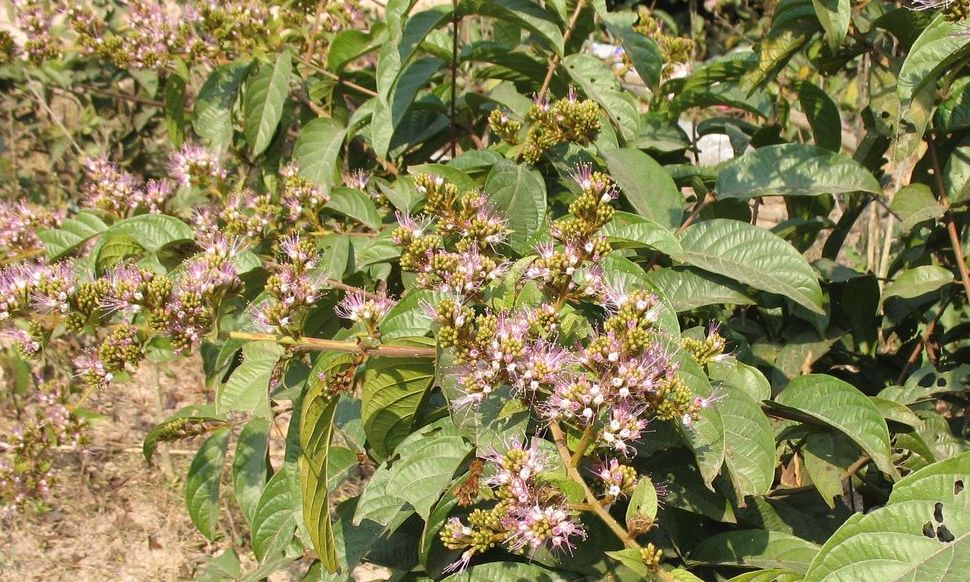
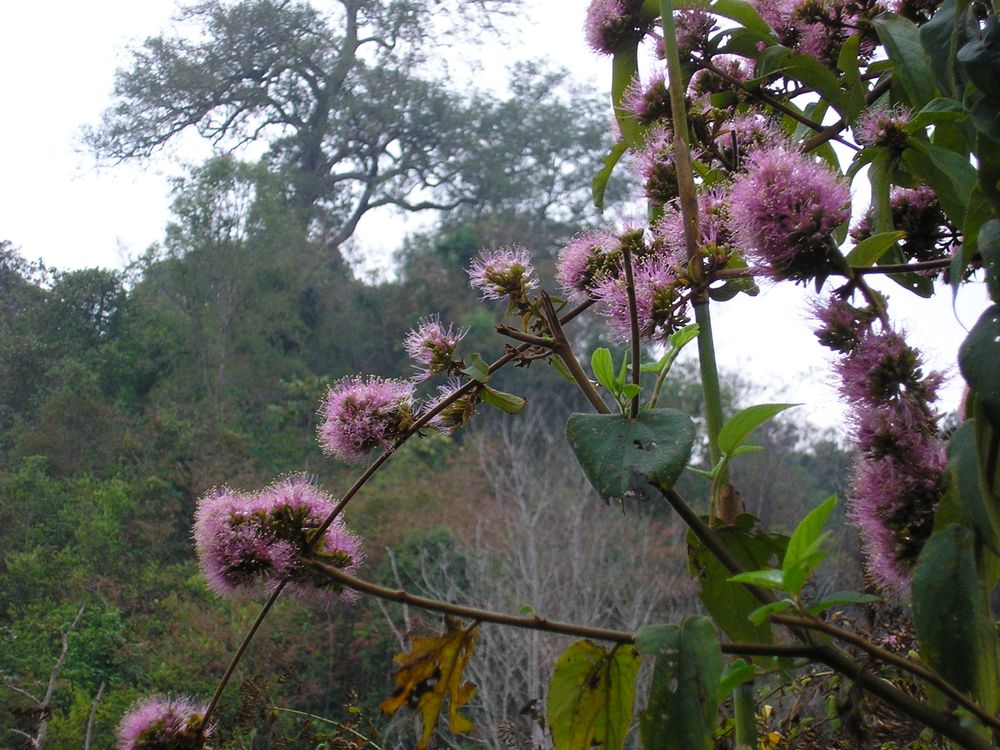
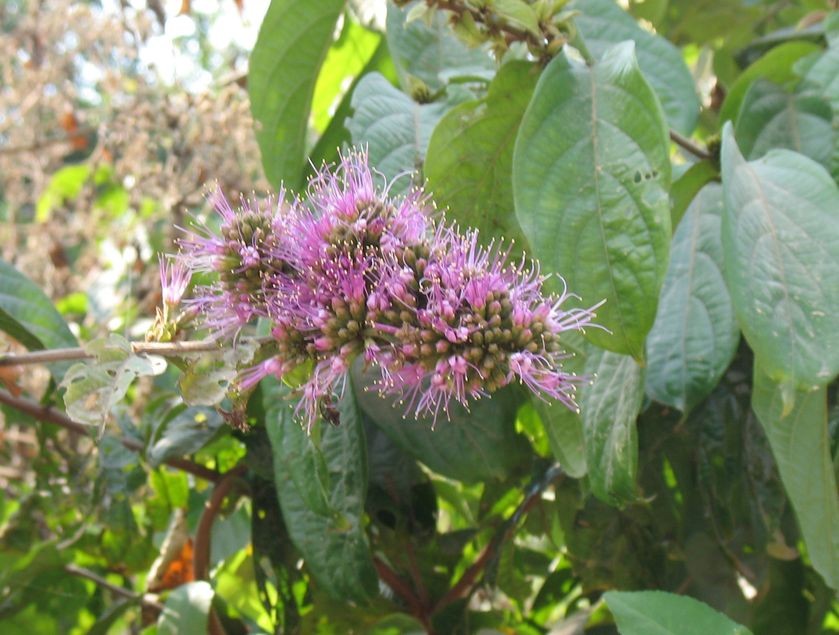
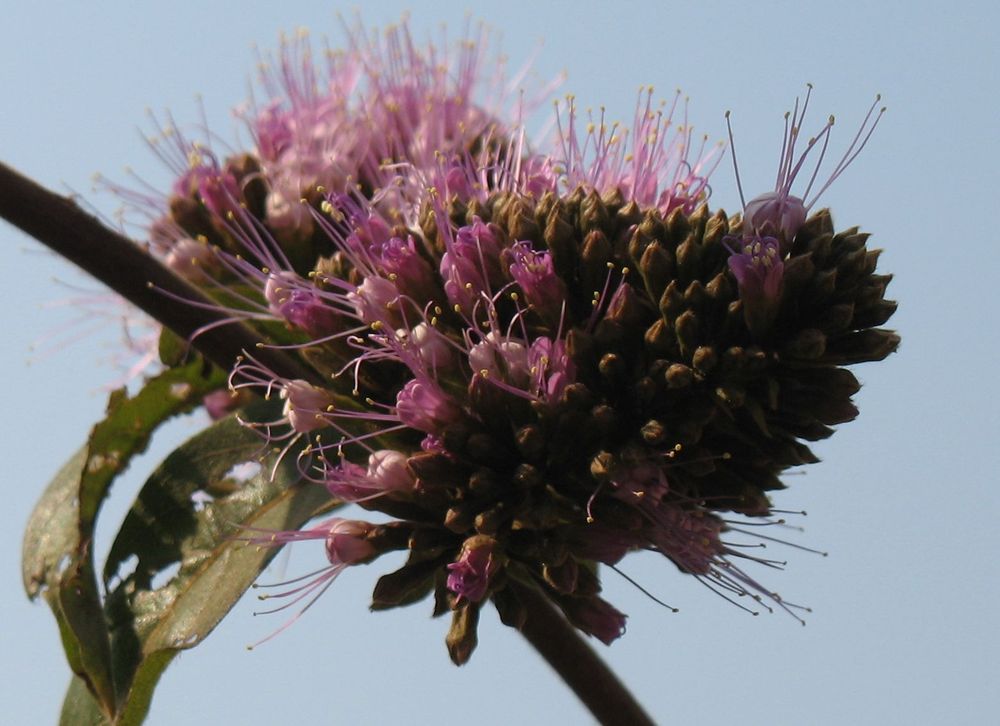
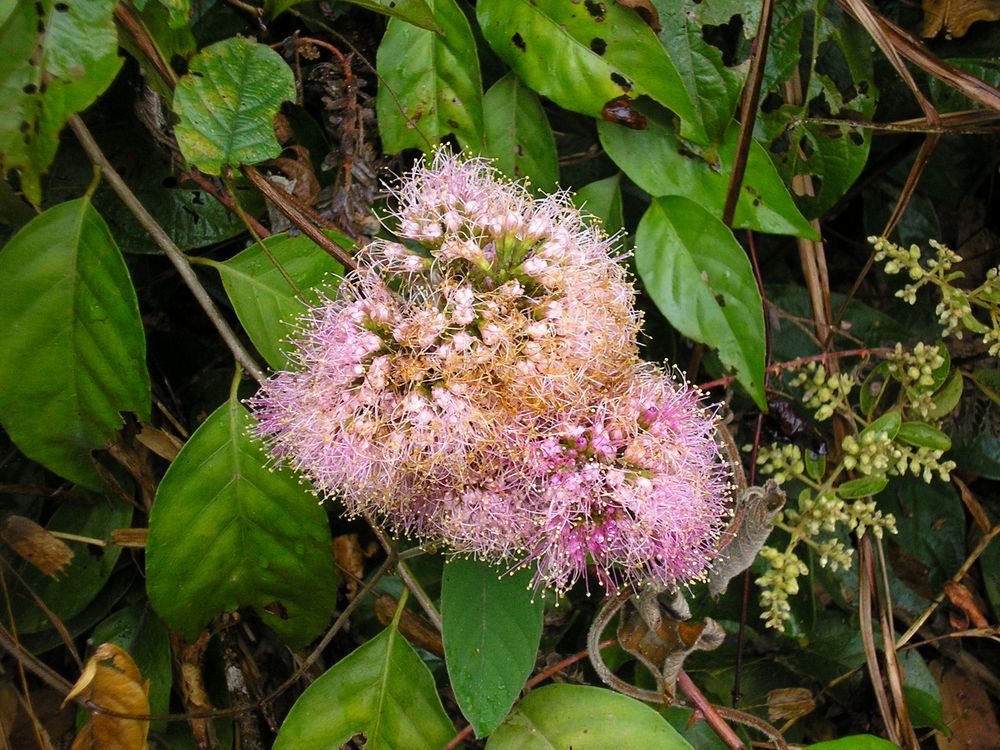
Combretum is a genus whose 300 species are all native to hot countries; this name was borrowed from Pliny who designated a plant that could not be identified.
Several Combretum are spontaneous in our region, in particular Combretum pilosum which one sees everywhere, in dry season, with its large purple puffs which cover the hedges. This liana is widespread in India, in tropical China and in the Indochinese peninsula.
As its scientific name suggests, its branches and twigs are covered with whitish hairs; its large oval leaves with well-marked veins are light green on one side, dark green on the other; they are often covered with galls.
Its small flowers are very numerous and form branched clusters at the end of the branch or at the axis of the branches. Each flower has five purplish, red, yellowish or sometimes white petals; they are closed and erect and let escape ten very long stamens which give to the flower its ruffled aspect. It is followed by a small pink fruit with five wings, hairy when it is young, glabrous and leathery afterwards.
One meets this liana of the North in the South of the country in the forests, the degraded zones, the wastelands where it goes up to the assault of the shrubs and goes down in the ravines. However, it is little used. Vidal notes its use as a black dye plant but none of our interlocutors could confirm this use. On the other hand, they speak of its use as a medicinal plant, the decoction of the branches being good for bringing down fever. They also say that the bushy branches of kheua phone are used to catch fish.
Combretum est un genre dont les 300 espèces sont toutes originaires des pays chauds; ce nom a été emprunté à Pline qui désignait ainsi une plante que l’on n’a pas pu identifier.
Plusieurs Combretum sont spontanés dans notre région, en particulier Combretum pilosum que l’on voit partout, en saison sèche, avec ses grosses houppettes violettes qui couvrent les haies. Cette liane est répandue en Inde, en Chine tropicale et dans la péninsule indochinoise.
Comme le suggère son nom scientifique ses branches et ses rameaux sont couverts de poils blanchâtres; ses grandes feuilles ovales aux nervures bien marquées sont vert clair d’un côté, vert foncé de l’autre; elles sont souvent couvertes de galles.
Ses petites fleurs très nombreuses constituent des grappes ramifiées en bout de branche ou à l’axe des rameaux. Chaque fleur a cinq pétales violacés, rouges, jaunâtres ou parfois blancs; ils sont refermés et dressés et laissent échapper dix très longues étamines qui donnent à la fleur son aspect ébouriffé. Lui succède un petit fruit rose à cinq ailes, poilu quand il est jeune, glabre et coriace ensuite.
On rencontre cette liane du Nord au Sud du pays dans les forêts, les zones dégradées, les friches où elle monte à l’assaut des arbustes et descend dans les ravines. Cependant elle est peu utilisée. Vidal note son emploi comme plante tinctoriale noire mais aucun de nos interlocuteurs n’a pu confirmer cet usage. En revanche ils parlent d’une utilisation comme plante médicinale, la décoction des rameaux étant bonne pour faire tomber la fièvre. Ils disent aussi que l’on se sert des rameaux touffus de kheua phone pour attraper les poissons.










Combretum is a genus whose 300 species are all native to hot countries; this name was borrowed from Pliny who designated a plant that could not be identified.
Several Combretum are spontaneous in our region, in particular Combretum pilosum which one sees everywhere, in dry season, with its large purple puffs which cover the hedges. This liana is widespread in India, in tropical China and in the Indochinese peninsula.
As its scientific name suggests, its branches and twigs are covered with whitish hairs; its large oval leaves with well-marked veins are light green on one side, dark green on the other; they are often covered with galls.
Its small flowers are very numerous and form branched clusters at the end of the branch or at the axis of the branches. Each flower has five purplish, red, yellowish or sometimes white petals; they are closed and erect and let escape ten very long stamens which give to the flower its ruffled aspect. It is followed by a small pink fruit with five wings, hairy when it is young, glabrous and leathery afterwards.
One meets this liana of the North in the South of the country in the forests, the degraded zones, the wastelands where it goes up to the assault of the shrubs and goes down in the ravines. However, it is little used. Vidal notes its use as a black dye plant but none of our interlocutors could confirm this use. On the other hand, they speak of its use as a medicinal plant, the decoction of the branches being good for bringing down fever. They also say that the bushy branches of kheua phone are used to catch fish.
Combretum est un genre dont les 300 espèces sont toutes originaires des pays chauds; ce nom a été emprunté à Pline qui désignait ainsi une plante que l’on n’a pas pu identifier.
Plusieurs Combretum sont spontanés dans notre région, en particulier Combretum pilosum que l’on voit partout, en saison sèche, avec ses grosses houppettes violettes qui couvrent les haies. Cette liane est répandue en Inde, en Chine tropicale et dans la péninsule indochinoise.
Comme le suggère son nom scientifique ses branches et ses rameaux sont couverts de poils blanchâtres; ses grandes feuilles ovales aux nervures bien marquées sont vert clair d’un côté, vert foncé de l’autre; elles sont souvent couvertes de galles.
Ses petites fleurs très nombreuses constituent des grappes ramifiées en bout de branche ou à l’axe des rameaux. Chaque fleur a cinq pétales violacés, rouges, jaunâtres ou parfois blancs; ils sont refermés et dressés et laissent échapper dix très longues étamines qui donnent à la fleur son aspect ébouriffé. Lui succède un petit fruit rose à cinq ailes, poilu quand il est jeune, glabre et coriace ensuite.
On rencontre cette liane du Nord au Sud du pays dans les forêts, les zones dégradées, les friches où elle monte à l’assaut des arbustes et descend dans les ravines. Cependant elle est peu utilisée. Vidal note son emploi comme plante tinctoriale noire mais aucun de nos interlocuteurs n’a pu confirmer cet usage. En revanche ils parlent d’une utilisation comme plante médicinale, la décoction des rameaux étant bonne pour faire tomber la fièvre. Ils disent aussi que l’on se sert des rameaux touffus de kheua phone pour attraper les poissons.


